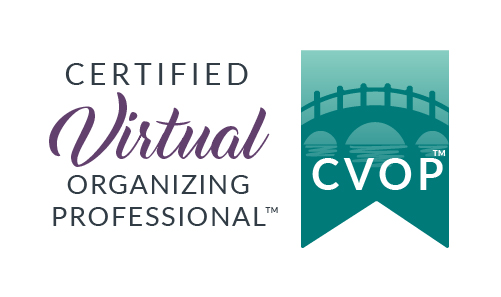In Order Blog
What’s Stopping You from Getting Organized? — Identifying 4 Barriers to Your Success and How to Tackle Them

Barrier #1: Difficulty Making Decisions
My colleague, Barbara Hemphill, has coined a phrase that I absolutely love. She states that, “all clutter is, is deferred decision making.” How true! If there’s a stack of papers sitting on your counter, it’s because rather than deciding what to do with a specific document (keep it, toss it, file it, pass it on), you didn’t make a decision and instead put the paper down on a surface. Indecisiveness happened again, and again, and now there’s a pile.
How to Deal With Making Decisions About Paper
The key purpose of a filing system is to be able to quickly retrieve the document you need, when you need it. Rather than feeling overwhelmed looking at a huge pile of papers, focus on each individual piece, one at a time. Ask yourself “where will I look for this when I need it?” and put it in a file labeled accordingly. Then move on to the next document. Keep going, one page at a time, until your pile has disappeared. If you’re not sure what to do with a document, put it in a “pending” folder and go back to it later.
Barrier #2: “I need to keep things lying around, out in the open, in order to remember to do them”
You are an “out of sight, out of mind” type of person. You believe you need a visual cue to remind you to act on something.
How to Deal With the Belief You Need to Keep Things Out and About
The fact of the matter is that when you have lots of stuff lying about, your environment becomes cluttered, making it difficult for you to see what’s actually there. The items become “wallpaper” and fade into the background. Rather than serving to remind you about a specific task, leaving items out makes it easy for you to overlook them. Instead, create a “To Do” list, or a Project List; the list serves as your reminder (you can even keep an electronic list on your smart phone or computer) and the item can be put away until you’re ready to work on that task. If you are afraid you’ll forget where you put the item, include that information on your to do list (e.g., Return Blouse to Macy’s – on shelf in front hall closet).
Barrier #3: If I Get Rid of This, I’ll Feel Guilty, or I Might Need It
I often work with clients who struggle with whether or not they should keep a specific item. They are not sure if they will need it in the future, or they feel guilty because they received the item as a gift.
How to Deal with Feelings of Guilt or Being Unsure
I often teach my clients that sometimes you have to hold onto the thought behind the gift, but let the physical gift itself go – especially if it’s something you don’t like, isn’t your taste, or it’s something for which you don’t have space or use. Gifts should be given freely and without guilt. However, if your Aunt Harriet is the type of person who will actually have the nerve to ask you where something she gave you is, you may just have to blame the cat for breaking it! If your concern is thinking you may need the item someday, ask yourself “What’s the worst thing that could happen if I got rid of this?” If you can live with the consequences, you can live without the item in question.
Barrier #4: Being Afraid That You Won’t Be Able to Find It If You Put It Away
If this has happened to you in the past, it’s no doubt because you randomly stashed things in a cabinet, drawer, or closet to get them out of sight, without having first designated a specific, categorized storage location. This likely led to a chaotic jumble of assorted items, making it easy for you to forget!
How to Deal With Easily Retrieving Items
The key to knowing where you put something is to create distinct, designated storage areas for specific types of items, and keep all of those items stored together. For example, the cabinet over your refrigerator might house all of your serving trays. The wicker basket on the shelf in your coat closet might be the designated home for all the hats and gloves. Store all of your holiday decorations in the same area, and place them in bins or totes separated by holiday (e.g., a bin for Halloween; a separate bin—or multiple bins—for Christmas; etc.) If your storage containers are opaque, consider putting a label on the outside of the container to easily identify the contents.



















